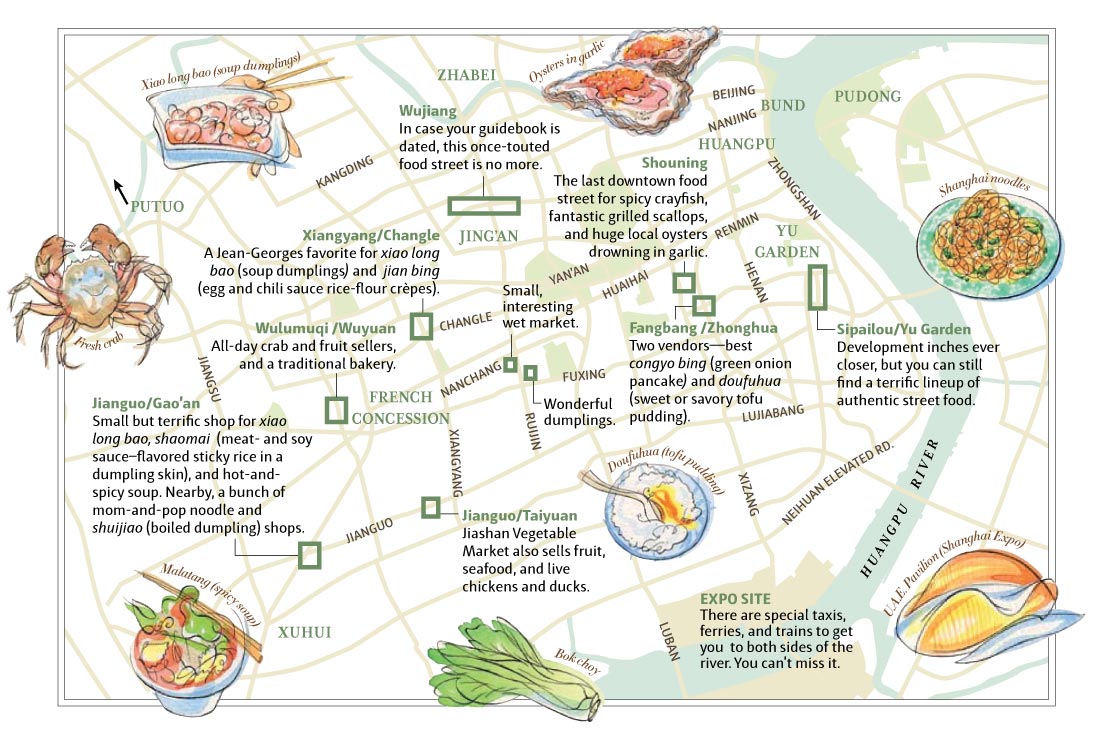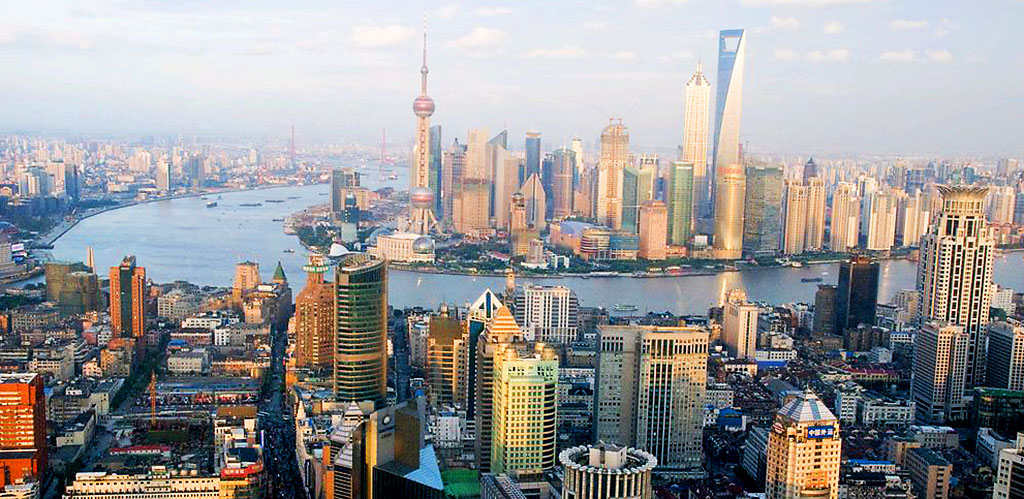Shanghai
Anthony Bourdain called Shanghai the most 'go-go' place on Earth. It's easy to see why. Shanghai, now a city of 23 million, spent the past couple hundred years as China's most cosmopolitan. For one thing, it's much more attractively located than Beijing, which basically fronts a desert. Shanghai, on the other hand, not only sits at the mouth of the powerful Yangtze River but also faces the East China Sea and like port cities the world over—from Mumbai to Casablanca to Hong Kong—acted as a magnet for the ambitious, the charlatan, and the adventurous. Today, Shanghai remains China's most cosmopolitan and now, the world's most modern and growing city.
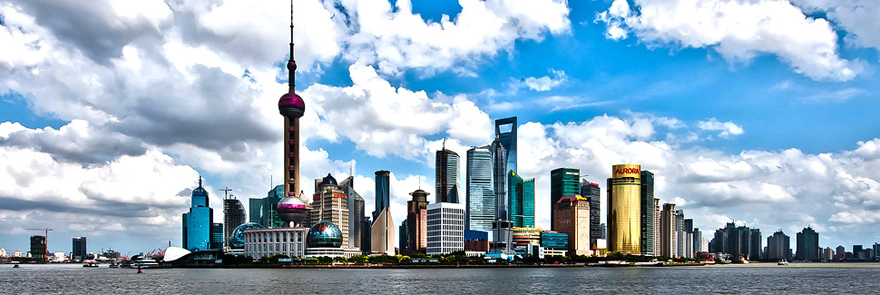
Orientation
The Huangpu River splits Shanghai in half, with Puxi west of the river where the Old Town still stands along the historic Bund, a remnant of a former concession in China., and newer Pudong to the east, home to many of Shanghai's famous skyscrapers, including the Oriental Pearl Tower, the Jin Mao Building, and the Shanghai World Financial Center.
Shanghai Highlights & Activities
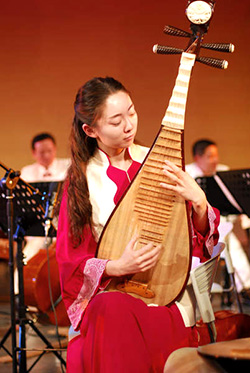
During this stay in the commercial capital, stay along the historic Bund, Shanghai's iconic area along the Huangpu River, which in the early twentieth century was home to banks, trading houses, and numerous consulates, which gave the city its international flair. Explore ancient and contemporary sites that will provide a glimpse of one of the world's most rapidly changing cities at the forefront of modernity.
Shanghai Concert Hall Near the Bund hotels.)
The Shanghai French Concession, also known as French town, was a former foreign concession during the period of 1849 to 1946. Here is Old Shanghai— ancient alleys, traditional lane houses, and small pockets of the city that have so far managed to escape wide-scale development. It includes the area of Luwan and Xuhui District, which has always been Shanghai's most charming district. Many of the small backstreets still have a very local feel, including Tianzifang, which was originally a typical lane factory area, and has been transformed into arts zone attracting art galleries who have retained the historic architecture and style of old Shanghai. The Arts and Crafts Research Institute is also located here, a museum in a former French mansion where you can observe artisans engaged in traditional Chinese arts and crafts such as paper cutting, embroidery, and making dough dolls.
Shanghai Museum— arguably China’s single best museum due to the scope and quality of its ancient art—bronzes, ceramics, paintings, furniture, calligraphy, jade, coins—and the technology it uses to display them so beautifully. The museum also houses a large collection of intricate ethnic-minority costumes—China has more than 50 ethnic minorities, and the exhibit highlights just how distinctive they are.
Shanghai Natural Wild Insect Kingdom. This museum housing all kinds of wild insects is a fascinating visit for kids. Pudong New near the Oriental Pearl TV Tower, where you can whiz to the viewing platform of the world's 6th highest tower (at 1,536 feet).
Bund Sightseeing Tunnel (north end of the Bund). The tunnel offers a five-minute ride under the Huangpu River from the Bund to the financial center in Pudong on the other side. The crossing is made in a car a bit like a ski gondola -- 10 people, standing, fit comfortably inside -- but instead of sky-high cables, it travels on a rail. The tunnel is lit up with odd disco lights and images of fish and lava. Buy a roundtrip ticket.
Jin Mao Tower (The Grand Hyatt building, Shiji Da Dao 2, Pudong, 3 blocks southeast of Oriental Pearl TV Tower). The second-tallest building in China (to its neighbor the Shanghai World Financial Center) offers stunning views of the river area from the observation deck.
Shanghai Municipal History Museum An interesting stop with children along with Jin Mao Tower (above), also near the Pudong's Oriental Pearl TV Tower at 1 Shi Ji Da Dao. Displays of a 19th-century cotton-making shop, a pharmacy and other establishments have life-size wax models, and videos show Shanghai's former racetrack and a Chinese neighborhood in the 1930s.
Science and Technology Museum (2000 Shi Ji Da Dao) Another good stop with the kids, a bit further from the Jin Mao Tower. Hands-on displays, including robots and other technology and science of interest to young children.
Huangpu River cruise (about one hour). Admiring and learning about the colonial-era structures trading houses from the 1920s and ’30s, of Old Shanghai, and across the river the space-age skyline of Pudong—the city’s financial district on steroids—contrasts New Shanghai. Highlights include the Jin Mao Tower, once China's tallest, now shadowed by the even taller World Financial Center and on the Pudong the Oriental Pearl Tower, the Shanghai International Convention Center with its twin glass globes, and a slew of hotels, offices, and malls of the Lujiazui Financial Area.. Between 10 a.m. and 6 p.m., the boats leave every hour on the hour or ask us to arrange a private one.
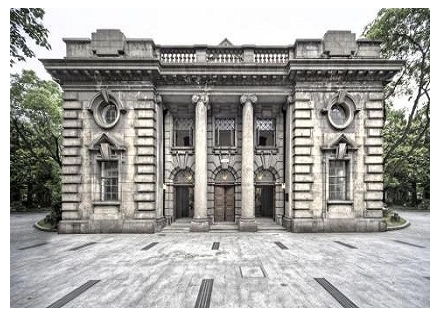
Hongkou Jewish history district. This area is the most significant in Jewish history in Asia. Shanghai's Hongkou District is the former Jewish quarter that was a ghetto in World War II, that in 1943 was home to over 20,000 Jewishrefugees, visiting the landmark Peace Hotel, Ohel Rachel Synagogue (right, by advance permit only), the restored Ohel Moishe Synagogue, and site of the former ghetto. Note: a comprehensive tour tour of Hongkou can be arranged with Mr. Dvir Bar-Gal an Israel Photojournalist who is based in Shanghai.
Era: Intersection of Time (2266 Gonghexin Lu) The Cirque du Soleil of China with acrobatics, theater, dance and music.
The Jade Buddha Temple (玉佛禅寺, Jade Buddha Chan Temple) In 1882, an old temple was built to keep two jade Buddha statues which had been brought from Burma. Although the original temple was destroyed, this one built in 1927 houses those holy relics in a temple of classical architectural.
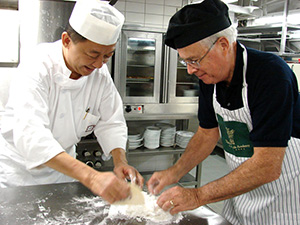
In the morning, enjoying a three-hour long dim sum cooking class. During this delightful class, learn the art and science of making dim sum the traditional Cantonese way hands-on with the guidance of a professional dim sum instructor. The class will be held in a cooking studio tucked in a peaceful residance lane in Shanghai's leafy French Concession quarter. The class includes a market tour and selection of student dishes by preference.
Shanghai Art Museum (325 Nanjing Road West). Exhibitions that range from to calligraphy to modern painting. Relocated in 2000 to the historic clock tower building on the northwest end of People's Square, the museum is more to be seen for its 1930s monumental interior architecture than for its art.
The Jiangnan Silk Museum shows how silk is produced from cocoons of silkworms and turned into fabric. The showroom offers everything from small souvenirs to larger items like silk duvets. Located at 289 Aomen Road in the Putuo District.
Shanghai Forever from JT Singh on Vimeo. See also A Walk in Shanghai
Shopping & Fashion
Xintiandi (新天地; "New Heaven and Earth" at Zi Zhong Road) 10 minute's walk from the Shanghai Museum is this affluent, car-free pedestrian shopping, dining and entertainment district. The cool and chic shops retain the original antique walls, tiles and exterior of the Shikumen housing of old Shanghai but the insides are typically modern. Near the French concession.
Silk
Silk is one enduring authentic product to still be found in modern China. The city of Suzhou located west of Shanghai is regarded as the "silk capital" and is the place to discover the finest silk products and visit their museum covering the history of the trade.
In Shanghai, Dongjiadu Fabric Market (now called the South Bund Fabric Market) is also good place to find silk. (ead more on silk in China).
Enjoy a unique shopping experience and a taste of old Shanghai if you want to buy a qipao (traditional dress). There are a lot of Qipao shops (both for ready-to-wear qipaos and tailor-made) on Shangle Road, in the Luwan District.
Shanghai Silk Building
Locals shop at the Shanghai Silk Building for its silk quality, located at Huaihai Road (226 Huaihai Zhong Lu, near Huating Road) and Nanjing Road (588 East Nanjing Road).
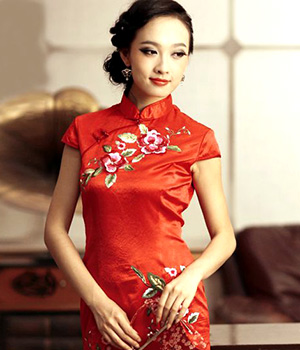
Shanghai Silk Mansion Company Ltd. is the largest retail and wholesale center for silk fabrics in Shanghai and is known as "The King of Silk” around the world. The company owns a wholesale store and 10 chain stores on main commerce streets of Shanghai. As the de facto shop for presents for traveling foreign and state guests, Silk Mansion has welcomed many VIPs, such as President Clinton and his family.
Shanghai is the epicenter for contemporary fashion in China, and today we'll visit a few shops on the cutting edge, and meeting with designers such as Shanghai-based California-born designer Cairn Wu Reppun (by prior arrangement and availability). For traditional flair, Shanghai's trademark dress is the iconic qipao, and the city has several outstanding tailors including Han Yi, who had made dresses for actress Maggie Cheung.
Often compared to Tokyo’s colorful Harajuku district, Huaihai Road is the fashion district of Shanghai. From international brands (Louis Vuitton, Channel) to local designers, all can be found on Huaihai Middle Road and it’s intersecting streets of Nanjing Road, North Sichuan Road, and Middle Tibet Road. While this is the main attraction for better known and commercial brands, locals also have an eye for smaller boutiques with emerging local designers, Shanghai’s interpretation of street ware, and eccentric looks. Changle Lu, the Marais of Shanghai albeit a smaller version, is just 2 blocks up from Huaihai and offers dozens of boutiques. One can fine pop-up stores, vintage clothing (primarily European), and curious vintage Chinese housewares. For people watching, Shanghahi’s hipsters frequent the courtyard at former location of Lolo Love Vintage (87 Wuyuan Road), also a popular haven to escape summer’s heat.
First Asia Jewelry Plaza, 3rd floor, 288 Fuyou Lu. China's The largest jewelry market (open 10-6 PM), near Shanghai's Yuyuan or Yu Garden Bazaar area, with an hundreds of shops dealing with pearls and stones of almost every imaginable variety.
FangHua Pearls, Shanghai. With branches in Beijing and Shanghai, FangHua is popular with trendsetters, celebrities and others.
Lilli's Shanghai Semi and precious stones and pearls including custom design and creation. 1D Maosheng Mansion, 1051 Xinzha Lu, www.lillishanghai.com
First Asia Jewelry Plaza, 3rd floor, 288 Fuyou Lu. China's The largest jewelry market (open 10-6 PM), near Shanghai's Yuyuan or Yu Garden Bazaar area, with an hundreds of shops dealing with pearls and stones of almost every imaginable variety.
Art & Design
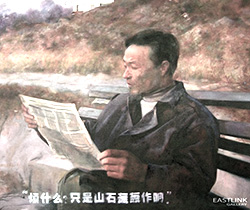
50 Moganshan Road (莫干山路50号) "M50" is Shanghai's version of SOHO. A converted-warehouse art district on Suzhou Creek. M50 hosts over 120 galleries and art studios. Many of Shanghai's best known artists work here, including& ;Zhou Tiehai, Ding Yi, Xu Zhen and the media art collective Liu Dao. Prime galleries include Aura, ShanghART, EastLink Gallery (with a branch in Beijing), Island6 and Biz Art.
Museum of Contemporary Art (231 Nanjing Road West). Opened in 2005, not on par with international museums but is the best place to view contemporary works in a pleasant environment. Third floor terrace cafe.
Accommodation
Waldorf Astoria
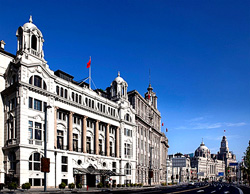
Boasting neo-classic architecture, lavish accommodations and modern facilities, Waldorf Astoria Shanghai On The Bund Hotel makes for a perfect base of luxury base for visiting The Bund. A newly built modern tower connects to an all-suite historic heritage building - The Waldorf Astoria Club - once the legendary Shanghai Club. Located at the center of The Bund, a city boulevard which runs alongside the Huangpu River and one of the most photographed postcard scenes of city, the Waldorf Astoria Shanghai on the Bund mixes the history and culture of the surrounding district with a taste for 21st century sophistication.
The Waldorf Suites in The Waldorf Astoria Club are decorated in classical European style with plush amenities, clawfoot bathtubs, exquisite chandeliers and the signature Waldorf poster bed. All 255 rooms and suites are fitted with state of the art in-room entertainment, a walk-in closet, and a marble-finished bathroom featuring a double vanity area with bathtub and separate shower. The new tower also houses a Noble Suite and a President Suite, each with two bedrooms laid out to impress. Many rooms overlook the scenic Bund while others feature views of the surrounding historic sites. Ask us review the performances at the European-style Shanghai Concert Hall close by. (Hotel Web Site)

The Peninsula
Elegant 235-room art deco hotel in Puxi fronting the Bund with views of the Huangpu River and the gardens of the former British Consulate. Public areas include a soaring lobby and glittering rooftop restaurant with skyline panoramas. Spacious rooms and suites combine user-friendly technology with understated but elegant furnishings. Executive suites have separate living and sleeping areas, walk-in dressing rooms and corner locations with windows on two sides. Marble baths provide separate shower stalls and tubs, TV/radios and hands-free phones. Other amenities include a signature ESPA spa, fitness center and 80-foot navy-and-white-tiled indoor pool.
Daytrips from Shanghai
Zhu Jia Jiao "water village'
Zhujiajiao "Ancient Town," only an hour from downtown Shanghai, is world's away from the city's hustle and bustle. Also known as a "water town," it is well endowed with waterways, dozens of picturesque ancient bridges, and traditional Chinese-style residences.
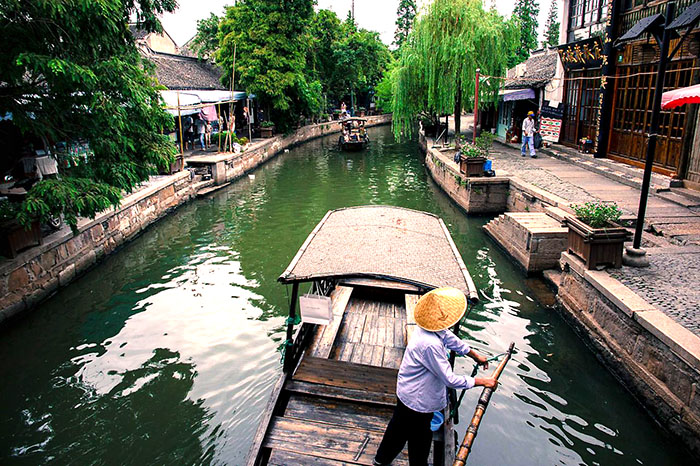
On this half-day visit the "Venice of the East" — Zhu Jia Jiao (朱家角 "Zhu Family Settlement"), a water village founded about 1,700 years ago though archaeological findings dating back over 5,000 years have been found. The village originally prospered through clothing and rice trade. Dozens of stone bridges and numerous rivers line Zhujiajiao, and thousands of ancient buildings still line the riverbanks today. It is the most well preserved in the Shanghai area, many centuries-old stone buildings are home to residents today and old historical buildings such as rice shops, banks, spice stores and even a Qing dynasty post office can still be found.
Shaghai Further Afield
Huangshan (Yellow Mountain)
Day 1 | Shanghai to Huangshan

Today journeying to visit picturesque Huang Shan, mountain landscapes that have inspired generations of poets and painters.
A UNESCO World Heritage Site, the area features stunning granite peaks spiraling into the sky. The area is also known for its ancient villages. This morning, depart by the newer high-speed train from Shanghai to Huang Shan, taking just over four hours. After arrival in Huangshan, venturing down to the confluence of the Heng, Shuai and Xian Rivers, to have lunch and explore Tunxi Street, a cobbled ancient lane dating all the way back to the Song Dynasty (960-1279) with local Anhui style of architecture. As well as charming local shops, there are a couple of small museums we may visit to learn more about the history of the area.
In the afternoon, transfer to resort with time to freshen up before heading over to a closeby Honchun village, a traditional settlement with courtyards dating from the Ming and Qing periods. After exploring the alleys and shops, enjoying an evening dance and musical performance.
Tonight, enjoying the spectacular performance "Aju," in nearby Hongcun village, a traditional drama employing amazing water effects with dancing, stunts and acrobatics are every bit as impressive as a Cirque du Soleil show, including snow, dazzling lightning, fog, and fire that appears to burn even in water (Tuesday and Sunday performances only).Imperial Mao Feng green tea in China is highly regarded, but the Huang Shan Mao Feng is considered the very best in China. On the slopes of the surrounding green hills in the area, Keemun Tea has also been produced exclusively since late 19th century, a special tea known for the orchid-like fragrance and non-astringent taste.
Mukeng Bamboo Forest in Huangshan is famous for being the location of the sword fighting scene in "Crouching Tiger, Hidden Dragon."
Day 2 | Huangshan to Shanghai
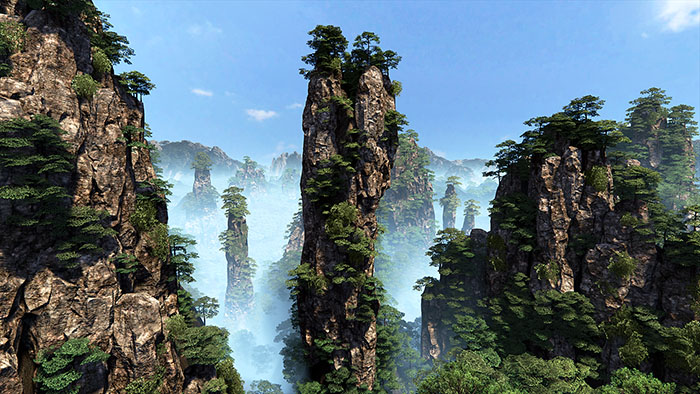
This early morning before sunrise, venturing out for a hike and cable car ride to a high promontory to savor the magnificent views over the Yellow Mountains at daybreak, an event known as the "Buddha's Light." Balance of morning hiking the mountain area (with a picnic breakfast) before returning back to resort to freshen up before drive back to Huangshan train station for high-speed train return to Shanghai.
Hangzhou
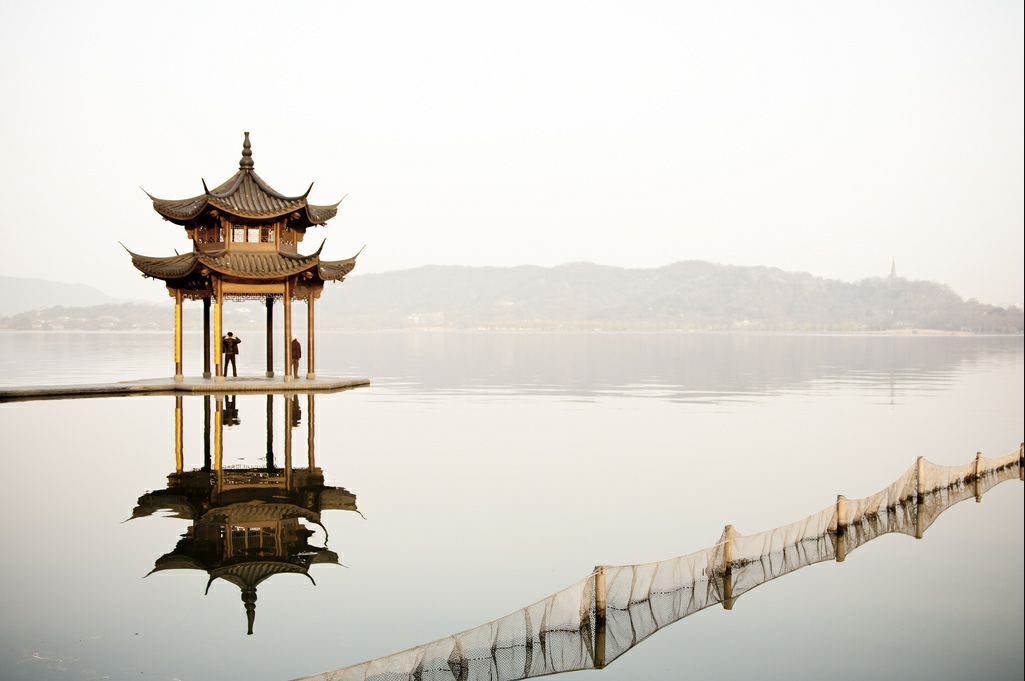
Given its location just 75 miles southwest of Shanghai, Hangzhou remains a place where the old and the new Chinas currently strive to coexist. Hangzhou has always been a prosperous city, thanks to its location at the southern end of the 1,100- mile-long Grand Canal and a terminus of the Silk Road, linking classical China with the ports of the eastern Mediterranean.
These days, however, the city enjoys a reputation as the most affluent in the entire country, where the newly wealthy of Shanghai buy hillside properties overlooking the bucolic West Lake, a combination of mountains and water which, like The Peak in Hong Kong, is said to possess especially potent feng shui, or mysteriously auspicious power. Hangzhou now possesses a population of more than six million, but despite its growing size, districts bordering the lake remain pretty, tranquil and clean. It is possible to walk, jog or cycle around much of the shoreline, pausing on the willow-shaded paths to gaze out across the expanse of glassy water. Aside from the lake, Hangzhou offers a number of fascinating monuments including the enormous 4th-century Lingyin Si Buddhist temple and the magnificent 10th-century Six Harmonies Pagoda.
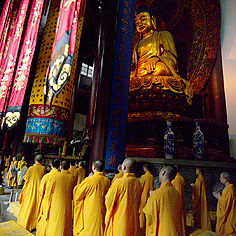
After arrival by the futuristic high-speed mag-lev train to Hangzhou (45 minutes), touring Lingying Temple (灵隐寺 "Soul's Retreat"), believed to be the oldest Buddhist temple in Hangzhou. The temple has gone through numerous cycles of destruction and reconstruction, but remains a picturesque monastery that is the largest of several temples in the Wulin Mountains. Here are a large number of interesting grottoes and religious rock carvings, the most famous of which is the Feilai Feng (飞来峰; literally "the peak that flew hither").
The temple complex is a popular pilgrimage spot, the crowds are also interesting: a line of crimson- robed Tibetan nuns here, a cluster of chanting monks there. The Great Hall houses a most striking Buddha, China’s largest, at 81 feet tall, gilded and planted on a giant lotus.
Hangzhou's Lingying temple may provide a deeper understanding the importance of Buddhism in Chinese culture, but here it’s equally critical to steep yourself in the significance of tea. Hangzhou is the source of China’s finest green tea: Dragon Well, named after a serene spring situated amid the tea plantations just outside the city. Indeed, Hangzhou is often described as “The Tea Capital of China” for its excellence in tea cultivation, and the hills surrounding West Lake produce the famous Longjing Tea.
At the National Tea Museum in Longjing Village is a great place to learn about tea and its important place in China’s history. There’s also a pleasant tea house in the museum grounds and a traditional tea ceremony can be arranged by preference. At the teahouse at Dragon Well Village, one may also learn about and sample the different varieties of tea which is said to have all manner of healing powers, from improving your eyesight to curing heart conditions to helping you lose weight. The finest is the spring harvest tea; a great vintage can fetch $1-300 per pound, but of a higher quality than what you can buy in the U.S., so this is the place to stock up. Interestingly enough, the Hangzhou way to drink tea is to “eat” it, leaves and all.
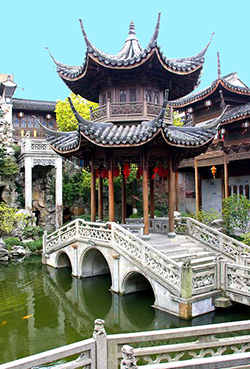
After tea, exploring Hangzhou’s Old Town and the former residence of Hu Xueyan, a wealthy Qing dynasty businessman. The magnificent courtyard garden is replete with its own lake, pavilions, a zigzag bridge, red carp, and tri-lingual parrots. After, dining on Hangzhou specialties (see below).
A short stroll after lunch to the museum that Hu Xueyan founded in 1874, the Hu Qing Yu Tang Museum of Traditional Chinese Medicine, where hundreds of medicinal plant and animal specimens are displayed, including bugs, snakes, and sea creatures (It’s a good thing you already ate). Here we may discover the old-world workshops where elderly pharmacists (called masters) demonstrate how they make herbal potions. Last comes the museum’s highlight: the pharmacy, where more white-coated masters scurry around filling herbal-medicine prescriptions, measuring and mixing all manner of strong-scented ingredients.
After the drugstore, visiting the Xiling Seal Engravers’ Society on Solitary Hill, a museum in a lovely location on a West Lake islet that is devoted to two of China’s indelible cultural traditions: calligraphy, which is not just a way of writing but a beloved art form; and the chop— or seal—a symbol of one’s identity and also an object of artistic appreciation.
To cap this visit to Hangzhou, embarking on a pleasant cruise on the lake, enjoying the beauty and romance of the peaceful setting. After docking, return to Shanghai by high-speed train with your guide.
Hangzhou Highlights
Given how important gardens are to Chinese culture, the Botanical Gardens does not disappoint—and is the place that best shows off the greenery and flowers for which Hangzhou is famous, especially in the photo-perfect late-afternoon light.
Hu Xueyan's former residence and Hu Qing Yu Tang Museum of Traditional Chinese Medicine. Hu Xueyan was a wealthy Qing dynasty merchant whose former residence is a jewel of a mansion, painting a beautiful portrait of nineteenth-century life. He also founded a nearby museum where a highlight are the old-world workshops where elderly pharmacists (called masters) demonstrate how they make herbal potions and the pharmacy, where more white-coated masters scurry around filling herbal-medicine prescriptions, measuring and mixing all manner of strong-scented ingredients.
Anxious to burn off some energy? The lake is a perfect setting for biking, and we can take a spin around the lake stopping at points of interest. The lake is also ideal for an early morning jog.
The Wetland Museum is a contemporary, almost futuristic, building which tells the history of the wetlands and its complex, fragile environment. There are many exhibits and a UFO-like observation tower. The park also has other attractions, such as Plum Villa, Autumn Snow Temple, Yanshui Fishing Villa, and Xixi Family House, which tell of the history and culture of the Hangzhou region.
Some of the best quality silk in China is sold on Hangzhou’s Silk Street. In earlier times, Chinese people would travel to Hangzhou to purchase silk sheets as gifts for newly married couples. That tradition continues today in many of the shops, but you can also find the most beautiful silk scarves, and swathes of quality silk for clothes. Don’t forget to bargain, it’s expected here. There is also the China Silk Museum (73-1 Yuhuangshan Rd.; 86-571-8703-5223), the world’s largest, which covers the history of silk and has a nifty gift shop, or the Hangzhou Silk Shopping Center, China’s biggest silk department store, which sells everything from silk umbrellas to silk hand cream and has a first-floor factory where you can see, step by step, how silkworms become duvets.
For last-minute shopping after dinner, there is the night market on Wushan. Of course the curios aren’t authentic, but the social scene is engaging.
Shanghai Dining
FINE DINING
The Chinoise Story
Shanghai & Classic Chinese Cuisine in the French Concession Located in what was once the French Concession, this lively restaurant occupies a striking two-story space that retains some of the art deco touches that characterize the landmark Jin Jiang Hotel, of which it is a part. The menu abounds with creative takes on Shanghai cooking, as well as classic Chinese dishes. Look for the deconstructed version of Peking duck with foie gras. The shrimp dishes are notably good and the dumplings are standouts.
59 Mao Ming South Road, Shanghai
Cost: US$90
Web: www.jinlu-china.com/index1.html
M on the Bund (Mishi Xicanting)
Lodged atop a handsome seven-story colonial building on the Bund, this is the restaurant that put Shanghai dining on the world map in 1999. All Art Deco elegance, M boasts a terrace that affords unsurpassed views of the Bund, the Huangpu River, and Pudong's skyscrapers, as well as a "Glamour Room" for nightly dinner and drinks. The fine menu changes frequently to take advantage of fresh local ingredients, but signature dishes include the slow-baked leg of lamb and the exquisitely sublime Pavlova dessert. Increased competition from the neighboring Bund restaurants has forced service to improve in recent years after a dropoff. M's has consistently been on the must-try list of many visitors, largely due to its previous renown and its glamorous environs, but where the quality, taste, and creativity of the food are concerned, quite a few expats prefer restaurants like Laris and T8. Reservations required. Zhongshan Dong Yi Lu 5 Tel. 021/6350-9988. US$30-70/person
Fu 1088
Fine Shanghainese in an elegant mansion At first glance, the appearance of this popular restaurant might surprise you — it is set in a Spanish-style mansion that dates to the 1930s. While the décor of dark wood and colorful tiles is not usually associated with fine Chinese cooking, that is what the kitchen delivers. You’ll find appetizers such as tea-smoked eggs and sweet lotus roots. Look also for deep-fried shrimp in wasabi sauce, luscious braised Shanghai pork belly, and pork dumplings filled with broth. $75
Fu 1088, 375 Zhenning Lu, Changning District, Shanghai (about 3 miles from The Bund)
Tel: 86 21 5239 7878
Review in FT.COM
Jean-Georges
World-class Asian-fusion on the Bund
Jean-Georges Vongerichten is consistently successful with Asian-inspired dishes: I think of his lamented Thai-inspired Vong and ever-popular Spice Market, both in New York. Here he is ensconced in Three on the Bund, a 1916 Beaux Arts building redesigned by Michael Graves in 2004, which reinvigorated the Bund with the Shanghai Gallery of Art, an Evian Spa and seven floors of shops. At Jean-Georges, the intimate, clubby atmosphere and attentive staff approach perfection, especially when paired with the famous chef’s impeccable Asian-fusion offerings: ribbons of tuna, avocado, spicy radish and ginger marinade; steamed tiger prawns, carrot juice, melon and wasabi; and red snapper crusted with nuts and seeds, all in a sweet-and-sour jus. US$110
4F, 3 Zhong Shan Dong Yi Road Shanghai
Yi Long Court (逸龙阁)
Peninsula restaurant cooks up some of the best Cantonese dishes in Shanghai "It's so rare to see such classic Cantonese food," says Shen Hongfei. "It's flavorful and light and it's almost like the food prepared for the managers of Thirteen Factories [an 18th-century foreign trade zone in Guangzhou]." One of Shen's favorites at Yi Long Court is beef with oyster sauce, which is "a long-lost classic Cantonese dish." To make the most out of the meal, book the eight-seat chef's table, prepared by executive chef Dicky To.
Ye Shanghai
Modern Shanghainese in Xintiandi chic teahouse Located in Xintiandi within an old colonial building. Real shanghainese food in an elegant setting.
Huangpi S Rd, 338号新天地广场北里6号楼
CASUAL DINING
Din Tai Fung is a an Asian-wide institution, widley celeberated for their Taiwan classic pork soup dumplings. Two locations inn Shanghai are the high-end IAPM Mall at 999 Huaihai Lu, near Shaanxi Nan Lu, and in Pudong, at the Super Brand Mall (168, Lujiazui West Road, Pudong). Note: closes at 9:00 PM.
Family pleasing Grandma's Home is a popular chain in China and the Hangzhou Mansion is also busy, often with a wait (but less so for lunch). Try their modern take on Hangzhou Beggar’s Chicken.
Lou Wai Lou (reservation in advance for the main dining room, as private rooms do not have lake-view tables) is Hangzhou’s oldest restaurant, located at 3 Gushan Rd, is on the same islet as the Seal Engravers’ Society. Dine the main dining room (the private rooms do not have lake view tables). Two recommended Hangzhou specialties: beggar’s chicken, baked in lotus leaves and clay, and shrimp bathed in Dragon Well tea.
Yee Chino, located on North Zhongshan Road, as much for the atmospheric decor as the food. The owners are restaurant interior designers, and have created a really romantic space with lots of private nooks decorated in rich red tones with comfy chairs, soft lights and music. The food is very good and served on beautiful dinnerware. The Kobe beef is authentic and delicious.
Sample delicious street food, like Xiao Long Bao and Chun Juan, along a traditional old street, Nan Song Yu Jie, during the evening. For finer dining, the Yee Chino Restaurant is popular for its well-designed Hangzhou cuisine as well as a cozy and eclectic interior which makes guests feel right at home in this city. The view from large plate glass windows offers great people-watching opportunities.
